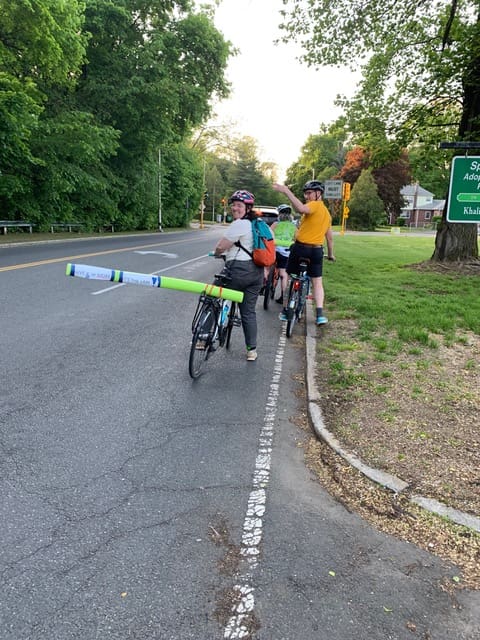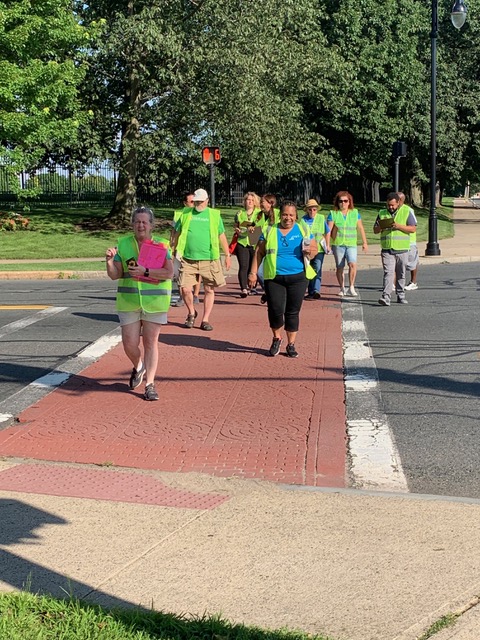
By Betsy Johnson
Walk Bike Springfield was awarded a 2022 America Walks GM Community Change Grant.
Exploring the Beauty in Everyday Walks
In 2014 our local planning agency recruited residents from across Springfield to develop a Complete Streets policy. By summer 2015, the City had failed to adopt the policy, so we started WalkBike Springfield. Within three months, we got the policy passed! Nine years later, we are still meeting monthly in an ongoing effort to improve the safety of walking and bicycling in Springfield, Massachusetts.
Successful projects include creating a bicycle network map, passage of a 25 mph default speed limit, passage of walking safety education for all second graders, assisting the City to obtain state and federal funds for complete streets projects, shared streets projects, and Safe Streets 4 All intersection and corridor improvements, and the building of Springfield’s first bike/skate park.
Springfield, Massachusetts located on the Connecticut River, with a population of just over 150,000, is the third largest city in Massachusetts and commercial center of western New England. Its roadways reflect 1960 – 70’s design – four lane arterials through neighborhoods, built to get folks in and out of Springfield rather than to ensure the safety of city residents. The focus of our AmericaWalks and Safe Roads Alliance grant was one of these arterials – a 3.3-mile stretch of Roosevelt Avenue.
Roosevelt Avenue Community Change Grant Project


Roosevelt Avenue is home to two colleges, four high schools, two middle schools, one elementary school, seven major employers, numerous other employers, senior housing and senior center Springfield’s second largest park with pool & skating rink, two churches, national guard facilities, and more – not to mention the residential areas of five neighborhood associations.
We applied for the grant because we wanted to be proactive, rather than just
responding to roadway projects being undertaken by the City and State. Through a variety of out-reach activities we gathered suggested improvements.
First, we developed a survey. This Google survey included illustrations and explanations of possible pedestrian and cyclist safety improvements. The survey was distributed to contacts at schools, businesses, neighborhood associations, and through the WalkBike Springfield network. We created a presentation that we gave at three neighborhood association meetings. At the meetings we collected surveys and recruited volunteers.
As part of Bike Month, we conducted a “Bike Audit”. Massachusetts had just enacted new vulnerable users legislation, which requires all vehicles to give cyclists, walkers and others using the roadway four feet passing distance. To demonstrate four feet, we attached pool noodles to the bicycles and road the length of Roosevelt Avenue. We also assessed where a shared used path was feasible versus protected and unprotected bike lanes.
We conducted three walk audits. One was with the assistance of the Springfield Health Department and the statewide pedestrian advocacy organization, WalkMassachusetts. We recorded that the four lanes could readily be only two lanes (road diet) because a narrower section already exists going under an underpass. We observed students from the high school running across the road to get to the sidewalk that exists only on the opposite side of the street. We mused that a round-about could make a three-way intersection (with a high crash history) actually crossable by pedestrians.
A second walk audit was held at the other end of Roosevelt by WalkBike Springfield volunteers on an August Sunday afternoon. This enabled us to more safely walk (against the traffic) because there are no sidewalks for most of this mile section. A key success of the audit was to determine that the pedestrian call button at the busy Page and Roosevelt intersection was not working (we waited through six cycles!) One of the participants reported the failure to “311” and the City has actually repaired the signal.
The third walk audit was with seniors from a senior apartment complex, which is only 1/3 mile away from the City’s new Senior Center. Additional thanks to AARP for supporting WalkMassachusetts who was able to assist us with this audit. There is a signal from the complex across Roosevelt to Blunt Park where the Center is located. But, the signal is timed for the students at the nearby high school – our seniors were unable to cross in the allotted time. Once across the street there are no sidewalks in the Park to the Center. An overall goal of the project is to identify the lower cost improvements (lengthening the pedestrian phase and installing “pedestrians in roadway” signs), as well as the more moderate-cost items, such as actually installing sidewalks.
We held a community forum. We sent invites and distributed flyers to the neighborhood associations, local businesses, and schools. Springfield Prep Charter School was our host. The large gymnasium enabled us the layout the 20 sections of enlarged Google map images of the entire 3.3 stretch of roadway. Thanks to the Pioneer Valley Planning Commission for creating the map sections. We started the forum with a presentation that summarized the findings from the surveys, as well as an overview of the kinds of improvements participants could suggest. Using sticky pads, folks then added to the map suggested ideas for improving safety of Roosevelt Avenue for all users.
Sixth, we have started the compilation of suggested improvements. As mentioned, a first focus is a listing of lower-cost items such as modifying pedestrian signals, installing school zone signage, installing radar detection speed signs, repainting crosswalks, etc. A second grouping are moderate-cost items such as installing sidewalks, installing crosswalk beacons, installing raised crossings, and painting bike lanes. The third grouping are improvements requiring more engineering such as installation of shared use paths, overall road diet, intersection round-abouts, and new signalization, for example.
Next Steps


The project has created momentum. We already have requests to conduct additional walk audits. We will continue out-reach to the employers and schools. We will more formerly present our recommendations to City and State elected officials and staff, and work with them to identify funding opportunities.